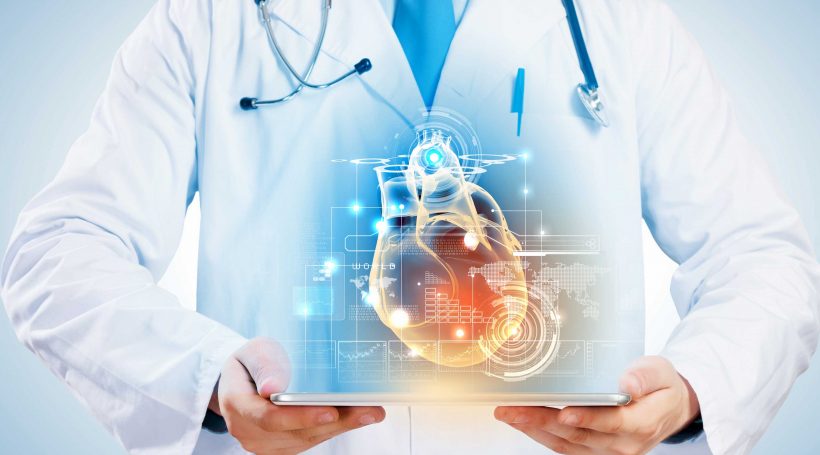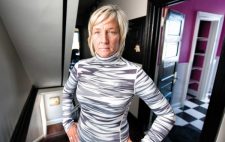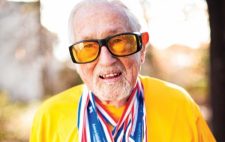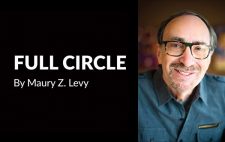When Andrew Josephson graduates from medical school, he just may replace his stethoscope with an iPhone. And he’ll be able to use an app he invented that could save the lives of people with heart disease – it’s already helped his mother.
Josephson, 24, represents an exciting trend in cardiac care: an explosion of high-tech advances including robotic surgery and other minimally invasive procedures.
“We’re in the middle of seismic change in healthcare,” says Reginald Blaber, MD, executive director of the cardiovascular institute at Our Lady of Lourdes Medical Center. “Things we used to do as inpatient procedures five years ago, we’re now doing as outpatient.”
Other advances – like Josephson’s app – may transform diagnosis and prevention.
Admittedly, the Moorestown resident’s invention had some unusual inspiration: In 2013, Josephson was moving boxes in his parents’ basement when he came across a stash of CDs labeled with his late grandfather’s name.
“He was a cardiologist, and throughout his career he’d been recording his patients’ heart sounds,” Josephson says. “Any time there was an interesting case or a rare heart sound, he would record it as a teaching tool for his students. After 30 or 40 years he’d amassed this collection of heart sounds, and he turned it into these digital mini-lectures on CDs.”
The following summer, Josephson, a Lehigh University graduate with a degree in biochemistry, taught himself to write software code and then built a smartphone app that records a heartbeat and compares it to his grandfather’s digital recordings. Using the comparison, the app detects abnormalities.
“The iPhone microphone is a really sophisticated piece of technology,” Josephson says. “On voice calls, the microphone is actually dumbed down in order to have the best quality sound. But through programming an app, you can jack up the quality of the microphone to pick up high and low frequencies. The trick is to isolate the frequencies you want. For this, I isolated lower frequencies. Your heartbeat is the sound of liquid moving through valves, so the frequency is much lower than someone’s voice.”
Josephson tested the app with his family members, recording their heartbeats for analysis. His mom’s findings showed an irregular heartbeat, even though Tina Josephson had no symptoms of a heart issue. A few months later, after becoming short of breath during a ski trip, Tina saw a cardiologist who discovered she had mitral valve regurgitation, a serious disorder that can result in heart failure. Last March, Tina had open-heart surgery and has since returned to an active lifestyle.
Josephson believes advances in medical technology will cause increases in self-diagnosis, early detection and prevention of cardiac issues.
“With my mom, some of the abnormal sounds the app picked up were lower than a human can hear, so they may not have been picked up by a stethoscope,” he says.
“A lot of tech companies are getting into personal health. Wearable technology is becoming a big hit, where you can monitor and track your metabolism and heart rate. It’s only a matter of time before they get more advanced, putting more information in the hands of the patient,” adds Josephson.
Supporters of this new technology say its biggest benefit may be the increase in patients who visit a doctor before developing symptoms.
Blaber, of Lourdes, says patients are often reluctant to visit a cardiologist because they fear heart surgery, but technological advances are reducing the need for open-heart procedures.
“At Lourdes, we’ve invested in robotic heart surgery,” he says. “It allows us to perform surgery on the heart without sawing through the sternum to open the chest.”
In a robotic procedure, the surgeon uses a console to control instruments that are inserted through centimeters-long incisions.
“The robotic arms go in, and we have incredible high-definition cameras inside the chest. The surgeon is working the instruments like he’s using the joystick of a $1.5-million video game,” Blaber says. “The ability of the instrument to articulate is better than our fingers. Even the best surgeon’s hand might have a shake, but the robot doesn’t even tremble.”
Other common heart issues are being resolved through minimally invasive procedures at Cooper University Health Care, which now offers transcutaneous aortic valve replacement (TAVR) under conscious sedation.
“We started doing this procedure a few years ago with high-risk patients or inoperable people,” says Janah Aji, MD, director of the Cooper Cardiac Catheterization Lab. “The nature of the procedure is far less invasive than open-heart surgery.”
With conscious sedation, the patient is given a mild sedative to reduce discomfort, but remains awake and able to communicate with physicians.
“With sicker people, if you avoid anesthesia and intubation, they do better,” Aji says. “The patient is awake the whole time and is sitting up a few hours later.”
The TAVR procedure is also performed on lower-risk patients under general anesthesia. The method of aortic valve replacement involves inserting a catheter into the femoral artery through the groin and threading it up to the heart. A bovine valve is inserted to replace the damaged aortic valve.
“That’s where the ingenious engineering comes in,” Aji says. “The tissue of the bovine valve is collapsed in a way that makes it so small you can use the catheter to thread it through the artery. There’s been so much progress because these things are getting smaller and easier to use. The first catheter we used for TAVR was about the width of a nickel. The one we use today is about the thickness of a piece of spaghetti.”
Andrew Josephson expects to see medical technology evolve in leaps and bounds as he finishes school and moves into the medical profession.
“The rate of technological advancement is increasing exponentially,” he says. “There are a lot more people doing a lot more things with technology, and that’s only going to pick up. Things will be easier to see, easier to detect and easier to treat. The technology is out there.”






